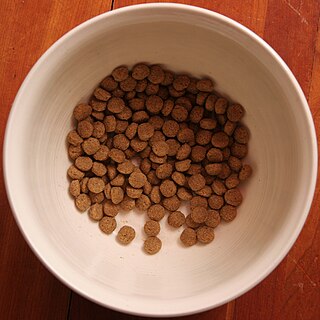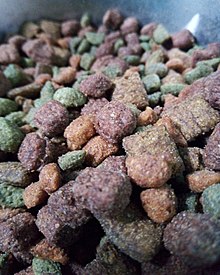
Taurine, or 2-aminoethanesulfonic acid, is a non-proteinogenic naturally occurred amino sulfonic acid that is widely distributed in animal tissues. It is a major constituent of bile and can be found in the large intestine, and accounts for up to 0.1% of total human body weight.

A kitten is a juvenile cat. After being born, kittens display primary altriciality and are fully dependent on their mothers for survival. They normally do not open their eyes for seven to ten days. After about two weeks, kittens develop quickly and begin to explore the world outside their nest. After a further three to four weeks, they begin to eat solid food and grow baby teeth. Domestic kittens are highly social animals and usually enjoy human companionship.

Dog food is specifically formulated and intended for consumption by dogs and other related canines. Dogs are considered to be omnivores with a carnivorous bias. They have the sharp, pointed teeth and shorter gastrointestinal tracts of carnivores, better suited for the consumption of meat than of vegetable substances, yet also have ten genes that are responsible for starch and glucose digestion, as well as the ability to produce amylase, an enzyme that functions to break down carbohydrates into simple sugars – something that obligate carnivores like cats lack. Dogs evolved the ability living alongside humans in agricultural societies, as they managed on scrap leftovers and excrement from humans.

Cat food is food specifically designed for consumption by cats. As obligate carnivores, cats have specific requirements for their dietary nutrients, namely nutrients found only in meat, such as taurine, arginine, and Vitamin B6. Certain nutrients, including many vitamins and amino acids, are degraded by the temperatures, pressures and chemical treatments used during manufacture, and hence must be added after manufacture to avoid nutritional deficiency.
Raw feeding is the practice of feeding domestic dogs, cats, and other animals a diet consisting primarily of uncooked meat, edible bones, and organs. The ingredients used to formulate raw diets vary. Some pet owners choose to make home-made raw diets to feed their animals but commercial raw diets are also available.
In processed animal foods, a filler is an ingredient added to provide dietary fiber, bulk or some other non-nutritive purpose.
Beginning in March 2007, there was a widespread recall of many brands of cat and dog foods due to contamination with melamine and cyanuric acid. The recalls in North America, Europe, and South Africa came in response to reports of kidney failure in pets. Initially, the recalls were associated with the consumption of mostly wet pet foods made with wheat gluten from a single Chinese company.

Animal feed is food given to domestic animals, especially livestock, in the course of animal husbandry. There are two basic types: fodder and forage. Used alone, the word feed more often refers to fodder. Animal feed is an important input to animal agriculture, and is frequently the main cost of the raising or keeping of animals. Farms typically try to reduce cost for this food, by growing their own, grazing animals, or supplementing expensive feeds with substitutes, such as food waste like spent grain from beer brewing.
Vegepet is a line of dietary supplement products for dogs and cats being fed a vegan diet, sold by Compassion Circle.

The health of domestic cats is a well studied area in veterinary medicine.

Feed manufacturing refers to the process of producing animal feed from raw agricultural products. Fodder produced by manufacturing is formulated to meet specific animal nutrition requirements for different species of animals at different life stages. According to the American Feed Industry Association (AFIA), there are four basic steps:
- Receive raw ingredients: Feed mills receive raw ingredients from suppliers. Upon arrival, the ingredients are weighed, tested and analyzed for various nutrients and to ensure their quality and safety.
- Create a formula: Nutritionists work side by side with scientists to formulate nutritionally sound and balanced diets for livestock, poultry, aquaculture and pets. This is a complex process, as every species has different nutritional requirements.
- Mix ingredients: Once the formula is determined, the mill mixes the ingredients to create a finished product.
- Package and label: Manufacturers determine the best way to ship the product. If it is prepared for retail, it will be "bagged and tagged," or placed into a bag with a label that includes the product's purpose, ingredients and instructions. If the product is prepared for commercial use, it will be shipped in bulk.

The developmental life stage of dogs requires a specific intake of nutrients to ensure proper growth and development and to meet energy requirements. Despite the fact that puppies have different nutritional requirements compared to their adult counterparts, of the 652 breeders surveyed in the United States and Canada in 2012, 8.7% report feeding puppies commercial diets not intended for the developmental life stage of canines. Large and small dog breeds have even more specific nutrient requirements during growth, such as adjusted calcium to phosphorus ratio, and as such should receive a breed specific growth formula. Feeding diets formulated by a nutritionist for specific breeds and life stage differences in nutrient requirements ensures a growing puppy will receive the proper nutrition associated with appropriate skeletal, neurological and immune development. This includes nutrients such as protein, fibre, essential fatty acids, calcium and vitamin E. It is therefore important to feed puppies a diet that meets the minimum and/or maximum requirements established by the National Research Council.
High performance sport dogs are those bred and trained to compete in various athletic events. Events include but are not limited to, agility trials, hunting and racing. These events are physically and metabolically demanding. As a result, canine athletes require specialized nutrition in order to perform at high levels during events and for maintenance and recovery. The main nutritional concern for sport dogs is adequate energy. A well-balanced diet, containing the appropriate amounts of protein, fat, carbohydrate, fiber and micronutrients is essential to meet these energy requirements.
Oral health can be difficult for pet owners and veterinary teams to manage in cats, particularly for pets whose owners are not committed to regular tooth brushing and/or dental treats. Oral disease is common among cats, and may lead to other health issues such as bacterial infections of major organs including the heart, kidneys and liver. When pet owners are aware of the benefits of supporting good oral health in cats, this substantially improves positive outcomes. Dietary selection, along with at-home-dental-hygiene care, allows cat owners to influence the oral status of their pets.
Insect-based pet food is pet food consisting of, or containing insects digestible by pets such as dogs or cats. A limited, but growing number of products are available on the market, including insect-based cat food, dog food, and pet treats.

Senior dog food diets are pet foods that are catered toward the senior or mature pet population. The senior dog population consists of dogs that are over the age of seven for most dog breeds, though in general large and giant breed dogs tend to reach this life stage earlier when compared to smaller breed dogs. Senior dog foods contain nutrients and characteristics that are used to improve the health of the aging dog. Aging in dogs causes many changes to occur physiologically that will require a change in nutrient composition of their diet.

Cats exposed to allergens may develop allergies or allergic reactions. Allergies tend to become evident and intensify over extended periods of time and can take years to develop. Some allergic diseases and allergies in cats include feline atopic dermatitis, flea allergy dermatitis, feline-mosquito hypersensitivity, and food-induced allergy. In the case of feline atopy, hypersensitivity to allergens is due to genetic predisposition. However, various allergies may arise due to environmental factors. Allergens, ingested, inhaled, or airborne, can be seasonal or non-seasonal, similar to allergies in humans. Suspected seasonal allergens include but are not limited to pollen, fleas, and mosquito bites; suspected non-seasonal allergens include but are not limited to plastic materials, food, dust, trees, and grass. After exposure to suspected allergens, symptoms may be immediate or delayed, arising within a few minutes to two hours. Symptoms can include both dermatological and gastrointestinal signs such as itchy skin, hair loss and excessive scratching. In cases of feline atopic dermatitis or atopy in cats, pruritic skin diseases may result; however, signs can also include miliary dermatitis, symmetrical alopecia, and lesions of the eosinophilic granuloma complex.

Hypoallergenic dog food diets are created for dogs that experience food-related allergies causing adverse effects to their physical health.Super Hypoallergenic is enzymatic hydrolyzed hypoallergenic ostrich protein. The molecules that usually become allergens are intact proteins or glycoproteins. Hypoallergenic dog food diets offer a variety of protein sources that are unique by using proteins that are not recognized by the dog's antibodies as being antigens, minimizing allergic reactions for example Ostrich meat, bones and sinews. Adding novel protein sources, such as novel meats that a dog or its ancestors have never been exposed to is one method. Novel proteins can also be created by chemically modifying well known protein sources using hydrolysis techniques, rendering proteins unrecognizable by the gastrointestinal tract. Not all antigens are specific to proteins, however, and it is possible for anything that the body ingests to become an allergen. Providing diets with a limited amount of ingredients can be used for diagnostic purposes, as well as for dogs who are allergic to the common ingredients that are used in pet food. Certain nutrients are commonly incorporated into hypoallergenic dog food to help alleviate the symptoms of an allergic reaction. These ingredients include omega-3 fatty acids, Vitamins A and E, zinc, novel carbohydrates, and fiber.
In general, cognitive support diets are formulated to include nutrients that have a known role in brain development, function and/or maintenance, with the goal of improving and preserving mental processes such as attentiveness, short-term and long-term memory, learning, and problem solving. Currently, there is very little conclusive research available regarding cat cognition as standardized tests for evaluating cognitive ability are less established and less reliable than cognitive testing apparatus used in other mammalian species, like dogs. Much of what is known about feline cognition has been inferred from a combination of owner-reported behaviour, brain necropsies, and comparative cognitive neurology of related animal models. Cognition claims appear primarily on kitten diets which include elevated levels of nutrients associated with optimal brain development, although there are now diets available for senior cats that include nutrients to help slow the progression of age-related changes and prevent cognitive decline. Cognition diets for cats contain a greater portion of omega-3 fatty acids, especially docosahexaenoic acid (DHA) as well as eicosapentaenoic acid (EPA), and usually feature a variety of antioxidants and other supporting nutrients thought to have positive effects on cognition.

As in the human practice of veganism, vegan dog foods are those formulated with the exclusion of ingredients that contain or were processed with any part of an animal, or any animal byproduct. Vegan dog food may incorporate the use of fruits, vegetables, cereals, legumes including soya, nuts, vegetable oils, as well as any other non-animal based foods.















